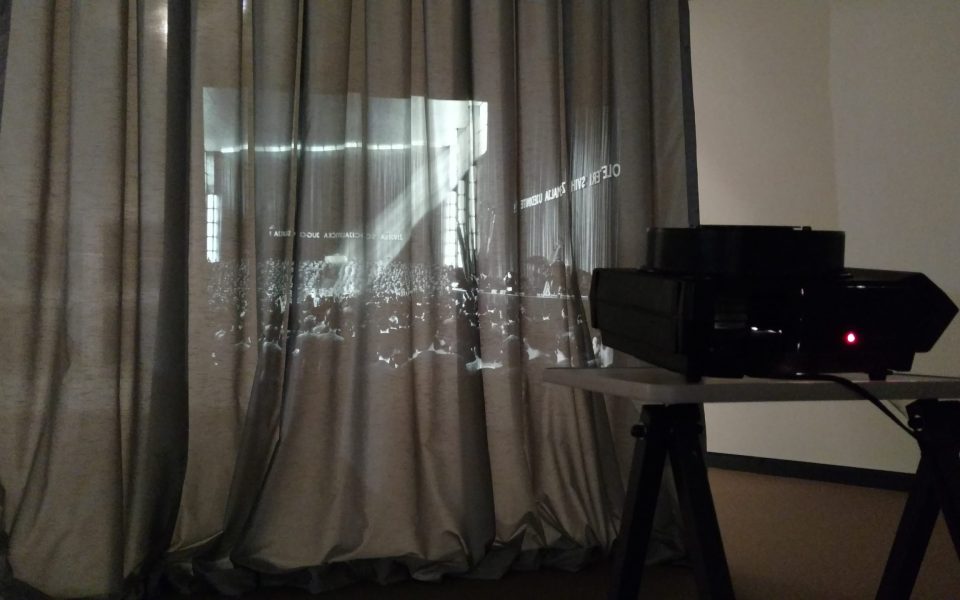Ascending the gallery stairs to a small loft, one hears an industrial hum, a mechanical churning, as if worn fingers busy their typewriters with the stories of lives and journeys forgotten. Ghostly workers in an otherwise empty room.
Though the surge of digital technology has kept dormant the rumblings of slide-projectors for several decades, there are many alive and toiling in the Hanes Art Gallery at Wake Forest University.
In the loft up the stairs, five projectors whir disparately, seemingly random at first approach but intentional in their timing, delivery and aesthetic. They produce images of homes and gatherings, travels and ruins, leisure, markets and, often, the stark-white vacancy of an empty slide. The recipient screens a few yards away all overlap so that none receives a full projection; instead the images fall from one screen to another. One viewer might see a kaleidoscopic distortion, and another a blend of collectivity. The intentionality endures; it’s the viewers’ perceptions that differ.
[pullquote]Lost Art continues at the Hanes Art Gallery through Jan. 22, and a Community Slide Show — a participatory part of this exhibit — takes place at SECCA on Jan. 19.[/pullquote]
Serbian-born artist Vesna Pavlović constructs such displays so that her audience not only focuses on the pictures being presented, but on its own act of viewing. Her Lost Art exhibit incorporates visual media from various sources, including prominent images from the archive of the Museum of Yugoslav History in Belgrade, the capital of her home country. Photographs of political meetings, patriotic stadium celebrations and old propaganda film canisters all have become material for new images and works of art. In literature on the exhibit, the gallery cites Pavlović’s “exploration of archives as repositories for personal, social and institutional memory.”
Viewers who wander Pavlović’s installation might get the feeling that the artist has contended with the trajectory of her own life as it crosses over this history and these events. The exhibit’s lack of dialogue with the viewer is almost frustrating, but many of the specific images that Pavlović has chosen to redress illuminate her own relationship to memory.
The biography on the artist’s website begins in 2007 with her receiving an MFA from Columbia University; it includes nothing of her previous life.
One can imagine that her Serbian roots — what were once Yugoslav roots before that country was torn apart — are not without the terrible anguish that plagued the region for many years. Recalling those memories may be a burdensome demand of Pavlović’s artistic life. As she challenges the viewer in an environment of examination, she must challenge herself, too.
A photograph captures a certain point in time, becoming a well-accepted proof of something having existed. Yet the image then journeys away from that flashing second without returning. Humans, clutching their photographs tightly, do the same from every passing moment. If a photograph is an interpretation or a receipt of what was once real, Pavlović exposes its power, its influence and its role in memory and political psychology.
One important projection connects the exhibit’s political images to the idea of social perception.
In the larger gallery downstairs, a single projector labors on. It casts images of presidential halls and other behemoths of bureaucratic institutions onto a dark gray curtain, undulating and weighty. (An Iron Curtain analogy here is by no means a stretch.)
There is a curious detail. Viewers first encounter the curtain when the projector is opposite them, and therefore has cast its image “correctly” through the curtain: what you’re meant to see. It’s not until the viewer moves to the other side that they see the image much less blurry and distorted — an image that hasn’t passed and been filtered through the heavy curtain — but one that is also now “backward” or “reversed”.
Again Pavlović challenges the audience’s act of viewing; her three-dimensional craft questions the viewers’ perception and convection of what they see versus what they’re shown: shades of the limitations and exploitations created by environments all around.
Join the First Amendment Society, a membership that goes directly to funding TCB‘s newsroom.
We believe that reporting can save the world.
The TCB First Amendment Society recognizes the vital role of a free, unfettered press with a bundling of local experiences designed to build community, and unique engagements with our newsroom that will help you understand, and shape, local journalism’s critical role in uplifting the people in our cities.
All revenue goes directly into the newsroom as reporters’ salaries and freelance commissions.


Leave a Reply